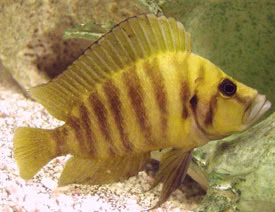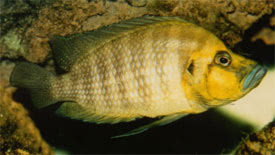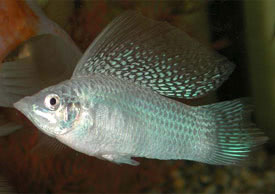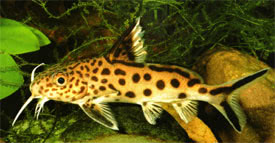
 Magyarul / Hungarian
Magyarul / Hungarian



- Scientific name: Altolamprologus compressiceps
- Common name: Compressed cichlid
- Synonyms: Lamprologus compressiceps
- Group: Cichlids
- Habitat: East-Africa, Lake Tanganyika
- Size: Male:15 cm, Female: 9cm
- Biotope: Endemic to rocky bottoms of the Lake.
- Social behavior: Territorial, peaceful towards tank mates of similar size, it will not attack plants or burrow. Possibly forms a patriarch/matriarch family.
- Diet: Carnivores; live food - enjoys small fresh fish best.
- Breeding: Very hard
- Tank: Minimum 150 litres
- Population: 4 fish for 200 litres
- Decoration: Needs a roomy tank with rocky formations full of caves as hiding places.
- Temperature: 24-28°C
- pH: 7-8
- Hardness: 10-20NK°
- Lifespan: 8-10 years
Description: The Compressed cichlid is high backed and has a very laterally compressed head and body. The forehead slopes down to a large mouth that is somewhat upturned. Its unusual body shape allows it to to slip through narrow cracks and crevices in rocks to catch small fish. The coloration varies greatly as multiple geographical color morphs are known. The most common variation beige body to light brown body color with about ten vertical stripes. The first one runs from the forehead, though the back part of the eye, and down to the lower part of the gill cover. The last is usually located on the base of the caudal fin. The fins are usually gold and the eye is dark. Often a short stripe from the eye the upper lip is present. Commercial fishes are almost exclusively wild-caught. The males are larger and become more high bodied than the female. Males also have longer fins.
For breeding the Compressed cichlid will need neutral, medium-hard water, pH about 7.0, 10 dGH°, at temperature between 24-26 °C. A shelter breeder, the female lays as many as 300 eggs in a cave that too small for the male to enter. The male will lay over the opening and release his sperm to fertilize the eggs. The female cares for the brood while the male guards the territory.


























